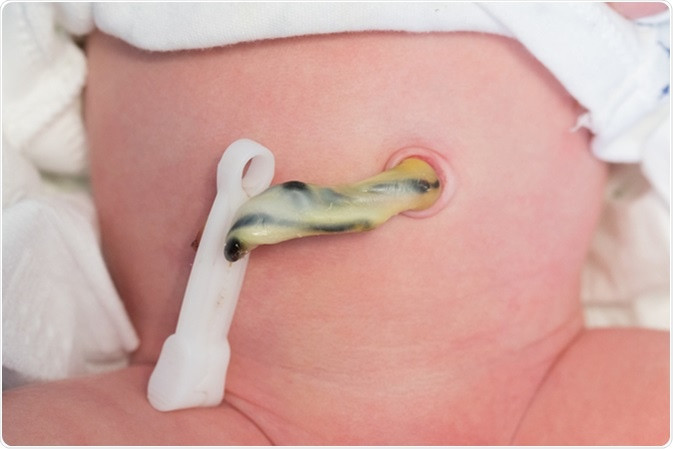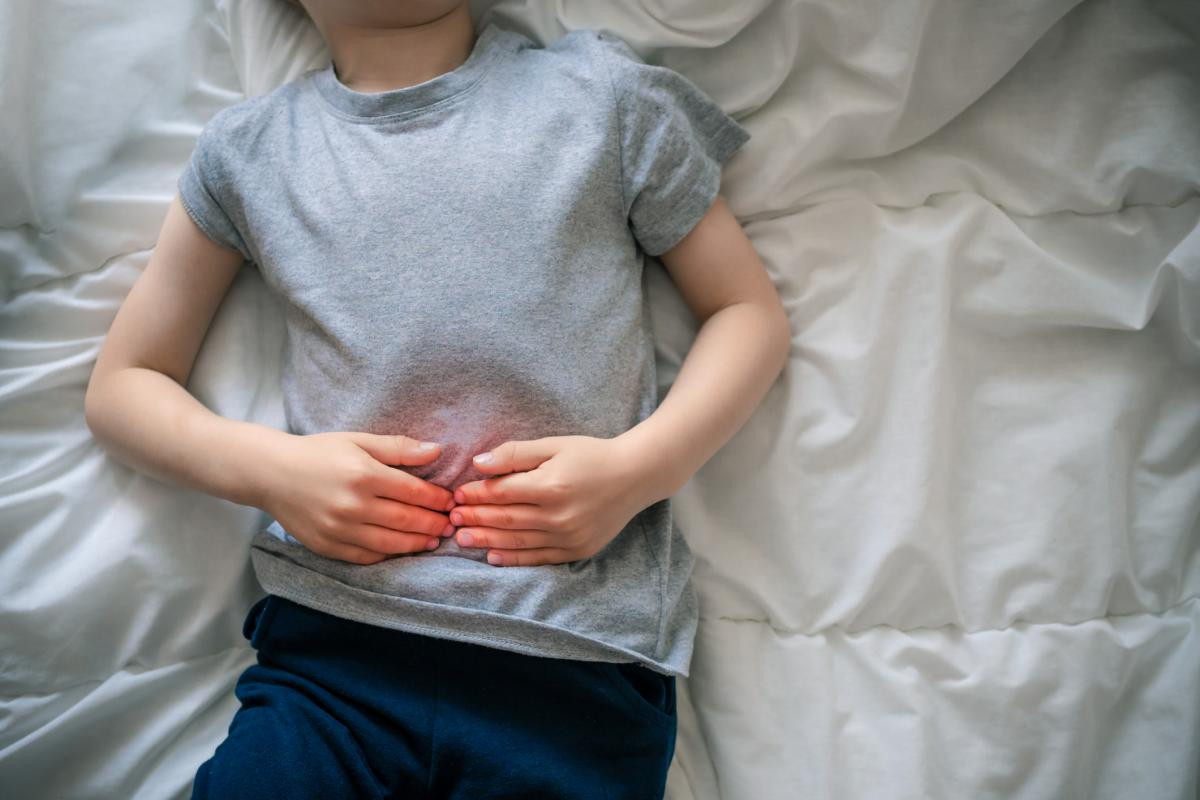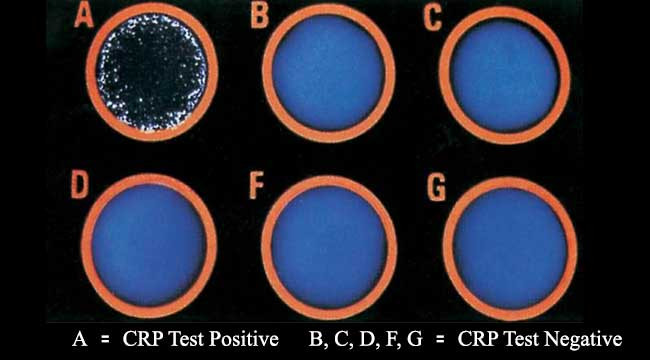Definition
Omphalitis is an infection of the umbilical cord and the tissue around it. It usually affects newborns within the first 28 days of life and is a serious medical emergency that can lead to a systemic infection and even death. Mortality occurs in 7-15% of all cases of omphalitis.
Causes
After the baby is born, the umbilical cord is cut off. However, if the tools used during labor and delivery are contaminated or not sterile, the area where the cord was cut can become infected. Also, if the equipment used during delivery is contaminated with amniotic fluid, the bacteria from the fluid can infect the incised area. The infections that can occur may be caused by different types of bacteria.
- Gram-positive bacteria, such as Staphylococcus aureus or group A Streptococcus
- Digestive tract bacteria, such as Escherichia coli
- Gram-negative bacteria, such as Proteus mirabilis or Klebsiella pneumoniae
- Chorioamnionitis (an infection of the amniotic sac) is caused by Bacteroides fragilis, Clostridium perfringens, and Clostridium tetani.
Cut umbilical cord cells usually decompose, desiccate, and spontaneously separate within 5 to 15 days. However, if it is contaminated with bacteria, the bacteria can proliferate significantly during this time period. As the umbilical cord remains attached to the infant's blood vessels, there remains a risk of bacterial penetration, which could result in systemic infections.
Risk factor
The following are risk factors that increase the risk of omphalitis:
- Low birth weight infants (<2,500 grams)
- Previous catheter or tubing insertion in the umbilical cord
- Premature membrane rupture can indicate pregnancy and childbirth infection. This situation can worsen if membrane rupture persists >18 hours before delivery.
- Delivery without medical assistance
- Maternal infection
It progresses faster in premature babies. Infections can start 3-5 days after birth in premature newborns, while progression takes 5-9 days for full-term newborns.
This disease is particularly prevalent in poor countries. The prevalence is directly correlated with communal habits or rituals. The practice of applying herbal substances, breast milk, animal waste, and ash to the umbilical cord is still prevalent in certain regions. Nevertheless, this activity has the potential to result in the contamination of the umbilical cord with hazardous microorganisms, such as Clostridium tetani.
Symptoms
The following symptoms may manifest as a result of omphalitis:
- Pain
- Redness
- Induration of the umbilical cord and surrounding tissue results in bulging of the skin.
- Excessive hemorrhaging or discharge of pus from the severed umbilical cord that cannot be halted. The discharge might be either odorless or malodorous.
Once the infection has spread throughout the body, the infant will exhibit signs of drowsiness, impaired responsiveness, feeding difficulties, elevated body temperature, or excessive irritability.
Diagnosis
To diagnose omphalitis, the doctor will perform a comprehensive interview (anamnesis) to identify the presenting symptoms, such as:
- Breastfeeding difficulty
- A decreased level of awareness typically leans towards drowsiness.
- Irritable
- Inactive motion
The doctor may inquire about the patient's obstetric history. An additional risk factor may arise when the baby's urine or feces are discharged through the umbilical cord, indicating an abnormal anatomical structure.
The doctor will also conduct a comprehensive physical examination, including temperature, pulse, respiratory rate, abdominal gas, skin irregularities, and impaired level of awareness. Afterward, the doctor will examine the umbilical cord region to identify indications of omphalitis, such as erythema, edema, discomfort, and purulent discharge, indicative of an umbilical cord infection. This will help assess the dissemination of infection to the subcutaneous tissues, musculature, abdominal wall, dorsal region, and scrotal covering in male infants.
The following laboratory tests are typically performed in this condition:
- Complete blood examinations
- Blood culture
- Culture of bacteria extracted from umbilical cord exudate
If there is an indication of systemic dissemination of the infection, diagnostic testing might be conducted:
- Hemostasis
- Urinalysis and microbiological culture
- Spinal cord cerebrospinal fluid culture
- Assessment of blood chemistry parameters, including glucose and calcium levels
- Blood gas analysis can also identify any complications arising from omphalitis. When a spreading infection is being considered, imaging tests are typically required. Imaging studies include computed tomography (CT) scans, ultrasonography (USG), and chest X-rays. This imaging technique can detect infections in other organs like the lungs, thickening of subcutaneous tissue, fluid accumulation, infection-related muscle and subcutaneous tissue, and aberrant anatomical structures.
Management
Omphalitis is an emergency case, and the treatment plans are as follows:
- Stabilise the infant. In critical condition, the newborn may need to be referred to the ICU.
- Antibiotics. Empirical antibiotics shall be administered immediately, regardless of the culture results. However, if the culture results become available, the antibiotics will be modified according to the specific findings.
- Surgery intervention. This procedure allows for the removal of dead or contaminated tissue around the umbilical cord if the infection has spread. After surgery, the baby will be observed for several days to monitor the progression of the disease.
- Nutritional intake. Infants with severe omphalitis obtain adequate nutrition by intravenous feeding. Once the condition improves, breastfeeding or feeding through a tube are both viable options.
- Supportive treatment. Supportive therapy refers to the provision of treatment focused on maintaining the baby's survival during the course of therapy. This therapy can be administered through methods such as respiratory support, intravenous fluid administration, medications to elevate blood pressure, transfusions, and other medical interventions.
Complications
The most severe omphalitis complications include:
- Shock results from the circulatory system failing to deliver sufficient blood to the tissues.
- Spreading infection to subcutaneous tissues, including connective tissue and tendons
- Inflammation of the abdominal wall
- Necrosis of the intestinal tissue
- Hepatic abscess, characterized by the presence of pus in the liver.
- Hematogenous vasculitis
- Obstruction of blood vessels
- Mortality
Prevention
The prevention of omphalitis is possible with baby delivery in a medical facility. This is because the health facility has more hygiene maintenance than other facilities. A sterilized set of medical implements is required to effectively remove the newborn's umbilical cord. Following this, the remaining portion of the umbilical cord must be coated with an antiseptic solution until completely dissolved. It is important to avoid herbal concoctions, animal dung, clay, and other non-sterile substances to prevent the risk of infection.
When to see a doctor?
medical attention if:
- The residual umbilical cord exudes either blood or white or yellow purulent discharge.
- Umbilical cord swelling
- Erythema surrounding the umbilical cord,
and if further indications are observed, such as an irritable infant when the region surrounding the umbilical cord is stimulated. Awareness of the risk of omphalitis in infants might be increased by considering risk factors for infections
Looking for more information about other diseases? Click here!
- dr Ayu Munawaroh, MKK
Gallagher, P. (2019). Omphalitis: Background, Pathophysiology, Etiology. Retrieved 14 January 2022, from https://emedicine.medscape.com/article/975422-overview
Painter, K., Anand, S., & Philip, K. (2021). Omphalitis. Retrieved 14 January 2022, from https://www.ncbi.nlm.nih.gov/books/NBK513338/
What to Know About Your Baby’s Umbilical Cord. Retrieved 14 January 2022, from https://www.webmd.com/parenting/baby/baby-umbilical-cord#












